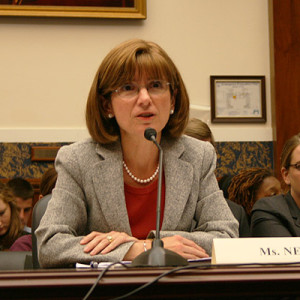
Debra Ness, president of the National Partnership for Women and Families, testifying before Congress on FMLA in 2009
August 5th, 2013 marks the 20-year anniversary of the Family Medical Leave Act – the nation’s first law guaranteeing most workers job-protected unpaid leave for certain medical or family emergencies. This week our blog will focus on the importance of family and medical leave programs and the need to pass the next generation of family and medical leave protections.
On August 5th, 1993, President Bill Clinton signed his first bill into law: the Family and Medical Leave Act (FMLA). The bill had been introduced to Congress each session for 9 years and was vetoed twice by President George H.W. Bush. But after nearly a decade of advocacy, U.S. workers were given their first federally protected right to unpaid time off for medical and family emergencies.
FMLA allows qualifying U.S. workers to take job-protected unpaid time off for certain medical emergencies such as the birth of a child or caring for a dying parent. It’s hard to believe that as recently as 1993 not even pregnant women could take a few days off to give birth to their child without risking their job. FMLA set a key baseline for U.S. labor practices by affirming that sometimes family must come first.
Calls for federal family leave policy were first spurred by the 1978 Pregnancy Discrimination Act, a law making it illegal to discriminate or fire women because they are pregnant. Coalition members recognized that the law didn’t fit all the needs of new families and that a comprehensive, gender-neutral policy was needed to best protect working families.
FMLA legislation was first drafted in 1984, led by the National Partnership for Women and Families (then known as “Women’s Legal Defense Fund”), and it was reintroduced every year until its passage in 1993. A key part of the National Partnership’s success was broad coalition support. In their near decade of advocacy, the National Partnership cultivated support from diverse advocacy groups working for women, labor, faith, disability, children, and seniors. These groups were instrumental in expanding FMLA to cover a diverse range of family needs – from paternity leave to taking care of elderly family members.
But 20 years after FMLA was first passed, nearly 40 percent of workers are not covered by the law and many workers can’t afford to take unpaid time off. It’s time to pass the next generation of family and medical leave protections. Several states have successfully created family leave insurance programs including California and New Jersey. It’s time for Washington to catch up. In 2014, EOI and the Washington Work and Family Coalition will be working to pass and implement Paid Family and Medical Leave Insurance in Washington – join us and demand action from our lawmakers on paid leave.
By EOI intern Elissa Goss
More To Read
September 24, 2024
Oregon and Washington: Different Tax Codes and Very Different Ballot Fights about Taxes this November
Structural differences in Oregon and Washington’s tax codes create the backdrop for very different conversations about taxes and fairness this fall
September 10, 2024
Big Corporations Merge. Patients Pay The Bill
An old story with predictable results.
September 6, 2024
Tax Loopholes for Big Tech Are Costing Washington Families
Subsidies for big corporations in our tax code come at a cost for college students and their families
